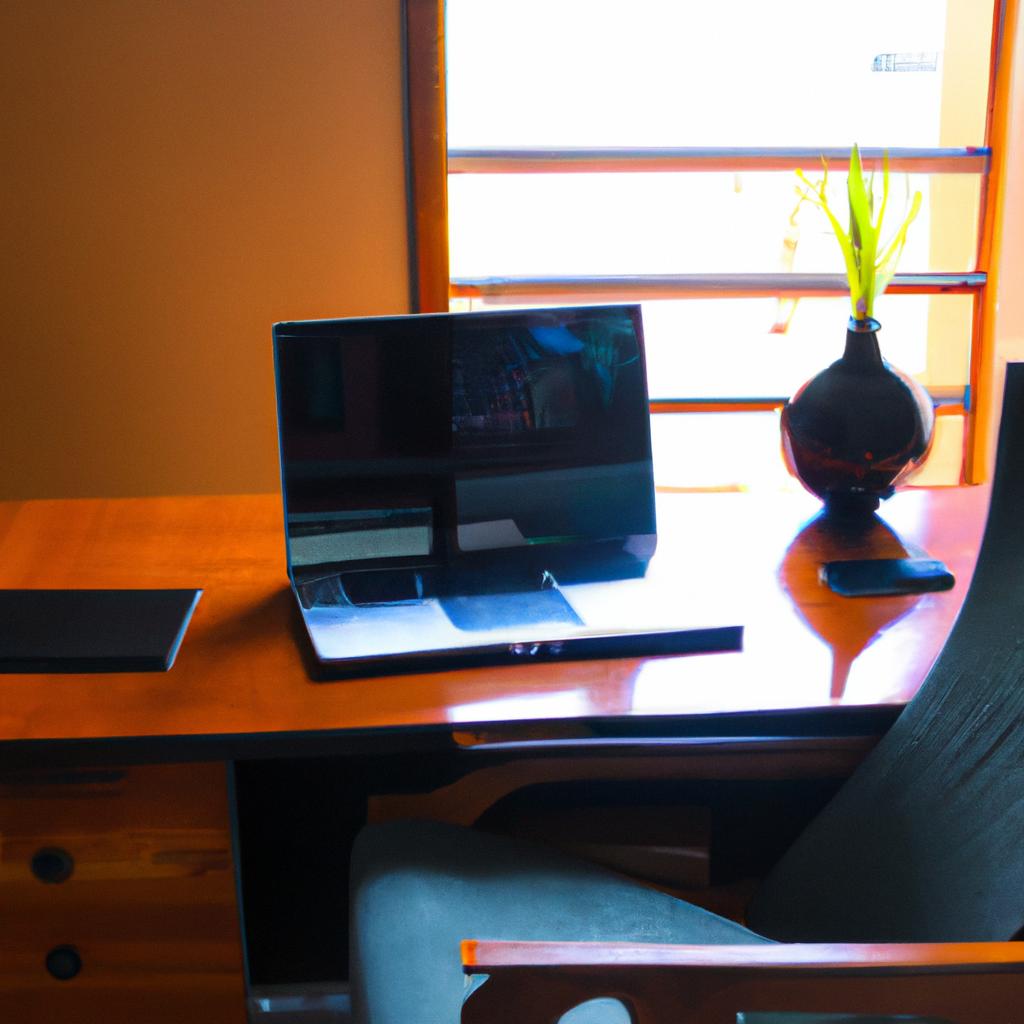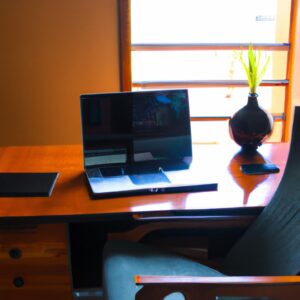Creating a Home Office: Design Ideas for a Productive Work Environment
Working from home can be both exciting and challenging. You have the freedom to manage your own schedule, work in pajamas, and take breaks whenever you want, but it also requires great self-discipline to stay productive. To make sure that you remain productive, creating a comfortable, organized, and inspiring workspace is essential.
Having a designated space for all your work activities ensures that you are focused on the task at hand and removes distractions from the TV, kids, or other household members. A well-planned home office not only helps to increase productivity, but it can also be an enjoyable feature in your home. To get started, let’s look at some home office design ideas that will ensure a productive work environment.
Home Office Design Inspiration
Having a productive and inspiring workspace is vital when working remotely. We have compiled some great design ideas from around the world to help you find the inspires you need to create your perfect home office.
For those of you with limited space, look no further than this Scandinavian inspired minimalist home office. The white walls and shelves provide the ultimate blank canvas for creativity, and the L shaped desk is ideal for maximizing the corner space. Introducing calming elements such as plants and natural wood finishes will add an extra layer of comfort and productivity.
If you are fortunate enough to have a larger space you can experiment with different layout options. An ergonomic setup with two desks and two chairs facing each other creates an inviting environment for creative collaboration or teamwork. Alternatively, create a larger L shape desk with plenty of storage space to help keep all of your materials organized and easily accessible.
Finally, don’t forget that your home office should be unique and tailored to your own aesthetic preferences. Be bold with bright colors and patterns, or opt for calming neutrals to mimic a spa-like atmosphere. Whatever you choose, make sure it personally inspires you and helps you stay focused.
Physical Considerations
When setting up a home office, you need to consider some physical factors in order to create a productive workspace. These include the space size available, the type of lighting, and any noise reduction techniques that can be employed.
The size of the space you have to work in will have an impact on what furniture and equipment you will be able to fit, so it’s important to measure up the space before making any purchases. You should also consider any natural light sources and how they can be maximised to your advantage.
Lighting is an important factor when creating a productive home office. Natural light is best for illuminating the workspace, but depending on the room layout, you may also need to incorporate some form of artificial lighting. Ensure that lighting is adjustable and that it illuminates the space evenly.
To reduce noise when working in a busy household, you can make use of noise-cancelling headphones or soundproofing materials to minimise outside noise. Investing in comfortable and ergonomic furniture will also help to reduce noise levels as it will absorb sound better than hard surfaces.
When considering space and lighting in your home office, remember to take into account the positioning of any windows or doorways. These can be used to great effect to increase natural light and create an ambient mood whilst keeping noise levels down.
By taking all of these factors into account when designing your home office, you can create a productive and enjoyable workspace that suits your needs.
Must Have Home Office Supplies
When crafting the perfect home office, having the right supplies is essential. Whether you’re working from home for the first time, or upgrading your existing workspace, there are a few things that are key to creating a productive and functional environment.
- Desk: Having a desk or table is the cornerstone of any good home office. For small spaces, consider investing in a space-saving design such as a foldable desk that can be tucked away when not in use.
- Chair: Your chair should provide adequate lumbar support while allowing flexibility to move freely. It needs to support your body in its natural curves. You may even want to try an adjustable desk for additional support.
- Storage Solutions: A well-organized workspace is essential to maintaining focus and productivity. Invest in storage solutions like shelves, drawers, and filing cabinets to ensure all your documents are neatly stored and easily accessible.
- Lighting: Good lighting is a key component for creating a comfortable workspace. Natural light is the best, but if this isn’t possible, consider adding LED lamps or other artificial lighting fixtures.
- Technology: Depending on the type of work you do, you may need more than a laptop and a phone. If you plan to video conference, invest in a web camera and microphone setup. Printers, scanners, and routers are also essential pieces of technology.
Having the right supplies can help make your home office comfortable and functional. With the right setup, you can stay productive and organized no matter where you are.
Keep it Organized: Tips for Maximum Efficiency
Having an organized workspace is essential for increasing your productivity and decreasing stress while working from home. There are a few simple steps you can take to maintain a neat and organized space.
- Create designated spots for items: Designate dedicated spaces for documents, stationery, books, notes and other items which will help you stay organized. Utilize boxes, shelving, folders, trays, etc. to store items properly.
- Avoid clutter: When working in an office environment, things quickly start to pile up on your desk. In order to avoid clutter, try to maintain a clean desk by cleaning up your workspace every day. Put away items that are not needed at the time in their proper places.
- Take out the trash regularly: Clean up your workspace regularly by taking out the trash and taking off the unnecessary papers that accumulate over time.
- Organize cables: Organizing cables is one of the most overlooked tasks, yet it is essential to maintain a productive space. Use cable ties and clips to keep wires and cables in order, so they won’t distract you from work.
- Label everything: Labeling items in your workspace will make them easier to find when you need them and will reduce the chances of misplacing them. Utilize labels, stickers, or even colorful markers to quickly locate paper items.
Following these tips and tricks will help you keep your workspace clean and organized for maximum efficiency. By creating a productive work environment inside your home office, you will have the ability to work more efficiently and reduce stress.
Ergonomics
Having an ergonomic setup is essential when creating a productive home office. Ergonomics in the workplace is about ensuring that furniture and equipment are arranged in such a way that it provides maximum comfort, safety and efficiency for the user. Incorrect posture while sitting at a desk or using computer equipment can lead to physical health problems such as back pain, neck pain, fatigue and repetitive strain injuries. By paying attention to the correct positioning of furniture, chair height and monitor placement, you can create an ergonomic workspace which will enable you to work comfortably for longer periods.
When setting up your office, consider the following:
- Chair height – a comfortable chair should allow your feet to rest flat on the floor without straining your legs.
- Back Support – your chair needs to provide good lower and mid-back support.
- Monitor Placement – your monitors should be placed no more than 20-30 inches from your face and at eye level to prevent neck strain.
- Keyboard Position – keep your keyboard at a comfortable distance with your elbows and wrists at a relaxed angle.
By taking into account the physical factors of your workspace, you can ensure that your home office is ergonomically sound and conducive to productivity. Remember to take regular breaks and stretch every now and then to stay comfortable.
DIY Home Office Hacks
No matter the size of your home workspace, there are ways to make it more stylish and efficient. DIY home office hacks can be an easy way to repurpose everyday items to add a touch of personality to your space. Here are some ideas to get you started:
- Use fabric to cover boring cardboard boxes for an attractive storage solution.
- Repurpose old mason jars as pen or pencil holders.
- Turn a spice rack into an organised station for keeping important documents.
- Reuse a wine cabinet as a place to store all your office supplies.
- Organize your cords and chargers with binder clips in a drawer.
- Hang a chalkboard on the wall and use it for brainstorming ideas or tracking progress.
If you’re handy with woodworking, you can also craft your own furniture like a wall-mounted desk or file folders. With a little bit of creativity and imagination, you can transform an ordinary space into something special.
Making it Yours – Personalizing Your Home Office
After the physical and practical aspects of your home office have been decided, it’s time to make it your own. A home office should reflect your individual style and personality. With the right decorations and accessories, you can create a unique space that promises an enjoyable and productive workday.
Consider adding elements of comfort like pillows, blankets and other soft items that are pleasing to the eye and to the touch. If you’re lucky enough to have a window in your home office, use it to infuse natural light and life into your workspace. Place additional passable lighting around the area to help give it a cozy and inviting atmosphere.
Another way to make your home office your own is to introduce artwork, plants, and photos that evoke personal meaning. You can be creative in how you display these items and rotate them frequently to keep your office looking and feeling new. To further show off your individual personality, hang up memorable items like diplomas, awards, or inspiring quotes.
Rather than cram every item into your office that you think might come in handy, break up the occasional overwhelming workday with novelty items like a mini-fridge, a snack corner, a coffee maker, or even a hammock. After all, you are responsible for creating an environment that best suits your needs.
Your home office will slowly change and evolve as you continuously express yourself in it. At times it may feel like a challenge to find items that match your style and fit the layout of your workspace, but it’ll be worth it in the end when your office is exactly how you imagined it.
Conclusion
Creating a productive home office environment is essential for those working remotely. With the right design, setup and supplies, you can transform your workspace into an efficient place to work from. Taking physical factors such as space size, lighting and ergonomics into considerations is important, as is staying organized and personalizing the workspace with your own sense of style.
We hope this guide has been helpful in giving you ideas and inspiration to create the perfect home office. With some careful planning and creativity, you can make your workspace work for you.
Useful Resources
- The Home Edit Shop The Look
- West Elm Home Office Collection
- IKEA Ideas for Working From Home
- DeskPass Guide to Home Office Ergonomics
comments: 0

